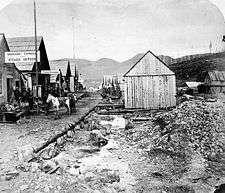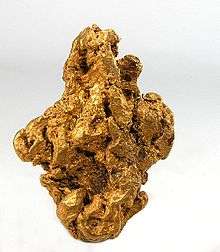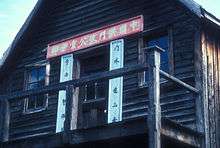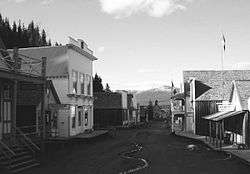Barkerville, British Columbia
| Barkerville, British Columbia | |
|---|---|
| Ghost town | |
|
Barkerville's main street, taken in June 2004, showing the historic buildings and a small stream of water flowing down its sloped, unpaved, roads | |
_location_map.svg.png) Barkerville, British Columbia Location of Barkerville within British Columbia | |
| Coordinates: 53°3′57″N 121°31′2″W / 53.06583°N 121.51722°WCoordinates: 53°3′57″N 121°31′2″W / 53.06583°N 121.51722°W | |
| Country |
|
| Province |
|
| Founded | 1862 |
| Historical town | 1958 |
| Elevation[1] | 1,230 m (4,040 ft) |
| Population | |
| • mid-1860s | 5,000 (Peak) |
| Area code(s) | 250, 236, 778 |
| Highways |
|
| Website |
www |
| Designated | 1924 |
Barkerville was the main town of the Cariboo Gold Rush in British Columbia, Canada and is preserved as a historic town. It is located on the north slope of the Cariboo Plateau near the Cariboo Mountains 80 kilometres (50 mi) east of Quesnel along BC Highway 26, which follows the route of the original access to Barkerville, the Cariboo Wagon Road.
History
Barkerville, once the largest city north of San Francisco and west of Chicago, was situated on the western edge of the Cariboo Mountains. It was named after Billy Barker from Cambridgeshire, England, who was among those who first struck gold at the location in 1861, and whose claim was the richest and the most famous.[2]
Barkerville grew up almost overnight, and was a case of "growth via word of mouth". Barkerville grew as fast as word of Barker's strike spread. His claim would eventually yield 37,500 ounces[3] (1,065 kg/2,350 lb) of gold.
Before the construction of the Cariboo Wagon Road, people hauled their own supplies to Barkerville, either on their backs or in a pack train. Because supplies were scarce, the prices of even the most everyday items were extremely high. High prices for goods in Barkerville did not ease up until the Cariboo Road had been finished, when goods could be transported by huge freight wagons. Soon, movers of freight boasted that they could pack and carry a set of champagne glasses without any breakage - for a price, of course. More women also came to Barkerville after the construction of the Cariboo Road.
Cattle were driven north up the Okanagan valley via what is now Highway 97 into Canada to provide meat for the miners and residents of Barkerville.

At first, the town consisted only of makeshift cabins and tents. By the mid-1860s, however, Barkerville had a population of approximately 5,000. Even though its population was transient and largely dependent on mining, Barkerville was becoming less of a service town and more of a real community. It had several general stores and boarding houses, a drugstore that also sold newspapers and cigars, a barbershop that cut women's as well as men's hair, the "Wake-Up Jake Restaurant and Coffee Salon", a theatre (the Theatre Royal),[4] and a literary society (the Cariboo Literary Society).


Horse racing and prize fighting were common entertainments. Among the so-called "sober set," church services were extremely well attended, but even with all these different stores the ones that made the most were the general stores. With them as the only source of food the store owners started increasing the price of food and supplies. In the height of the gold rush the stores sold flour for as high as $1.25 per pound. Beans, meat, and dried fruit were sold for a dollar a pound. But as the gold rush ended the stores went bankrupt and in the end were left with nothing.
People of Chinese descent were an important part of Barkerville life for almost a hundred years. They established a number of businesses, including the Kwong Lee Company, a general store that sold groceries, clothing, hardware, and mining tools. The company had stores in other parts of British Columbia, but the Barkerville store was one of the most impressive in town. The Chinese community also built cabins (for Chinese miners, who saved money by sharing four or five to a cabin) and Tai Ping (the "Peace Room"), the equivalent of a modern nursing home. Chinese benevolent associations provided social services to the Chinese community, and also resolved disputes within the Chinese community without the use of BC courts.
On September 16, 1868, Barkerville was destroyed by a fire that spread quickly through the wooden buildings. Rebuilding began immediately, and at an impressive pace. Within six weeks, ninety buildings had been rebuilt. Boardwalks were improved and the narrow and winding main street was widened and straightened. By 1880, there were enough children in the area to build the Barkerville School. It had just thirteen pupils and one piece of school equipment - a chalkboard. Even so, Barkerville's population was declining by the end of the century and it eventually only had a few people resident. It did, however, have a revival in the 1930s, when the Great Depression caused widespread unemployment, and the price of gold skyrocketed. But as the depression turned for the better, Barkerville declined to a very small village.[5]
Barkerville Historic Town
In 1997, the government of British Columbia decided that the town should be restored and operated as a tourist attraction. Today, Barkerville appears as it did in its heyday and is referred to as Barkerville Historic Town. The history of each building has been researched and documented. No actual residents remain; they were either bought out or moved to New Barkerville during the restoration of the site.

In 2008, Barkerville's Chee Kung Tong Building[6] was designated a National Historic Sites of Canada. The two-storey board and batten structure was completed in 1877 and originally used by the Chee Kung Tong organization, a benevolent association for recent arrivals; illustrates the community building among immigrant Chinese labourers and merchants in new settlements throughout Canada.
Climate
Barkerville has a subarctic climate (Köppen climate classification Dfc), resulting in long, cold and snowy winters, accompanied by short and cool summers due to its high altitude.
| Climate data for Barkerville | |||||||||||||
|---|---|---|---|---|---|---|---|---|---|---|---|---|---|
| Month | Jan | Feb | Mar | Apr | May | Jun | Jul | Aug | Sep | Oct | Nov | Dec | Year |
| Record high °C (°F) | 10.0 (50) |
15.0 (59) |
17.2 (63) |
27.8 (82) |
31.5 (88.7) |
33.0 (91.4) |
35.6 (96.1) |
33.9 (93) |
32.5 (90.5) |
26.7 (80.1) |
18.9 (66) |
14.4 (57.9) |
35.6 (96.1) |
| Average high °C (°F) | −2.9 (26.8) |
−0.5 (31.1) |
3.0 (37.4) |
7.2 (45) |
12.5 (54.5) |
16.2 (61.2) |
18.8 (65.8) |
19.0 (66.2) |
14.0 (57.2) |
7.2 (45) |
−0.3 (31.5) |
−3.5 (25.7) |
7.6 (45.7) |
| Daily mean °C (°F) | −7.5 (18.5) |
−5.9 (21.4) |
−2.8 (27) |
1.4 (34.5) |
6.2 (43.2) |
10.0 (50) |
12.3 (54.1) |
12.1 (53.8) |
8.0 (46.4) |
2.4 (36.3) |
−4.3 (24.3) |
−7.8 (18) |
2.0 (35.6) |
| Average low °C (°F) | −12.1 (10.2) |
−11.2 (11.8) |
−8.5 (16.7) |
−4.4 (24.1) |
0.0 (32) |
3.8 (38.8) |
5.8 (42.4) |
5.3 (41.5) |
2.1 (35.8) |
−2.3 (27.9) |
−8.3 (17.1) |
−12.0 (10.4) |
−3.5 (25.7) |
| Record low °C (°F) | −46.7 (−52.1) |
−43.3 (−45.9) |
−37.2 (−35) |
−26.1 (−15) |
−15.0 (5) |
−6.7 (19.9) |
−3.9 (25) |
−7.8 (18) |
−13.3 (8.1) |
−30.5 (−22.9) |
−42.0 (−43.6) |
−41.7 (−43.1) |
−46.7 (−52.1) |
| Average precipitation mm (inches) | 96.0 (3.78) |
60.7 (2.39) |
66.4 (2.614) |
58.2 (2.291) |
77.7 (3.059) |
101.9 (4.012) |
100.0 (3.937) |
80.6 (3.173) |
81.7 (3.217) |
92.3 (3.634) |
111.2 (4.378) |
95.0 (3.74) |
1,021.7 (40.224) |
| Average rainfall mm (inches) | 8.2 (0.323) |
3.4 (0.134) |
8.6 (0.339) |
25.6 (1.008) |
66.0 (2.598) |
101.1 (3.98) |
100.0 (3.937) |
80.6 (3.173) |
80.4 (3.165) |
64.6 (2.543) |
19.3 (0.76) |
2.5 (0.098) |
560.3 (22.059) |
| Average snowfall cm (inches) | 87.8 (34.57) |
57.3 (22.56) |
57.8 (22.76) |
32.6 (12.83) |
11.7 (4.61) |
0.8 (0.31) |
0 (0) |
0 (0) |
1.3 (0.51) |
27.7 (10.91) |
91.9 (36.18) |
92.6 (36.46) |
461.4 (181.65) |
| Average precipitation days (≥ 0.2 mm) | 16.6 | 12.5 | 13.8 | 14.3 | 18.7 | 20.6 | 19.2 | 16.0 | 16.3 | 18.0 | 18.7 | 17.1 | 201.7 |
| Average rainy days (≥ 0.2 mm) | 1.4 | 1.2 | 2.9 | 8.2 | 17.6 | 20.5 | 19.2 | 16.0 | 16.2 | 13.9 | 3.8 | 1.0 | 121.9 |
| Average snowy days (≥ 0.2 cm) | 15.9 | 11.8 | 12.2 | 8.4 | 3.0 | 0.3 | 0 | 0 | 0.6 | 6.5 | 16.4 | 16.6 | 91.8 |
| Source: [7] | |||||||||||||
Notable people
See also
- Cariboo Gold Rush
- Cariboo Road
- Cottonwood, British Columbia (Cottonwood House)
- Coldspring House
- Beaver Pass House
- Stanley, British Columbia
- Old Cariboo Road
- Fraser Canyon Gold Rush
- British Columbia Gold Rushes
- Billy Barker
References
- ↑ http://archive.copanational.org/PlacesToFly/airport_view.php?pr_id=3&ap_id=832
- ↑ BC Names entry "Barkerville (community)"
- ↑ "John Cariboo Cameron". Archived from the original on 14 June 2007. Retrieved 2007-07-18.
- ↑ "Theatre Royal, Barkerville". Newman & Wright Theatre Co. Retrieved 2012-12-19.
- ↑ Barkerville.ca
- ↑ Chee Kung Tong Building. Canadian Register of Historic Places. Retrieved 29 October 2011.
- ↑ "Canadian Climate Normals 1981-2010 Station Data". Environment Canada. Retrieved April 17, 2016.
External links
| Wikimedia Commons has media related to Barkerville, British Columbia. |
- Official website
- Stories of the British Columbia gold rush
- Rudimentary map of the area
- Biography of William Barker
- The Great Fire of Barkerville – 1868 An eyewitness account by the photographer Frederick Dally.
- The Cariboo Trail An article by E. Pauline Johnson which includes description of a visit to Barkerville
- Barkerville city directory, 1887
 |
Wells | Bowron Lake Provincial Park |  | |
| Stanley | |
|||
| ||||
| | ||||
| Likely |
